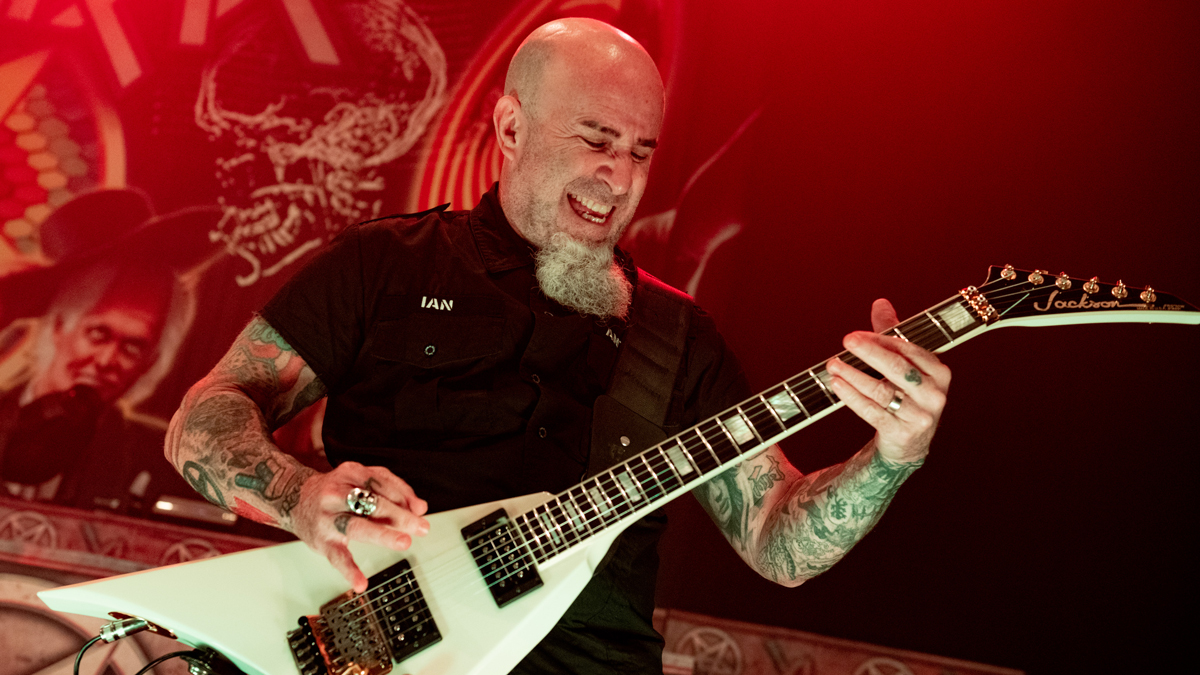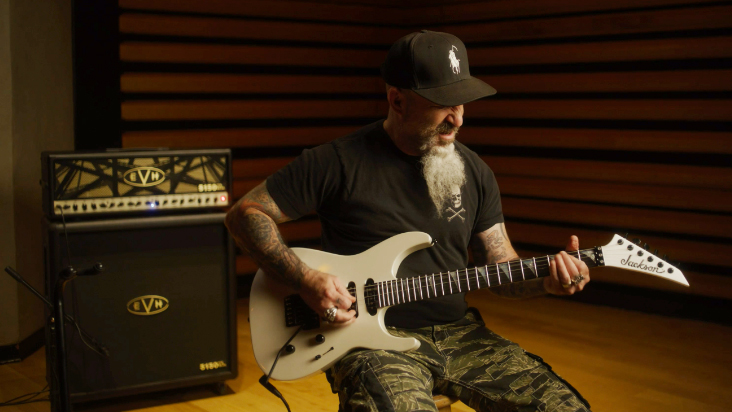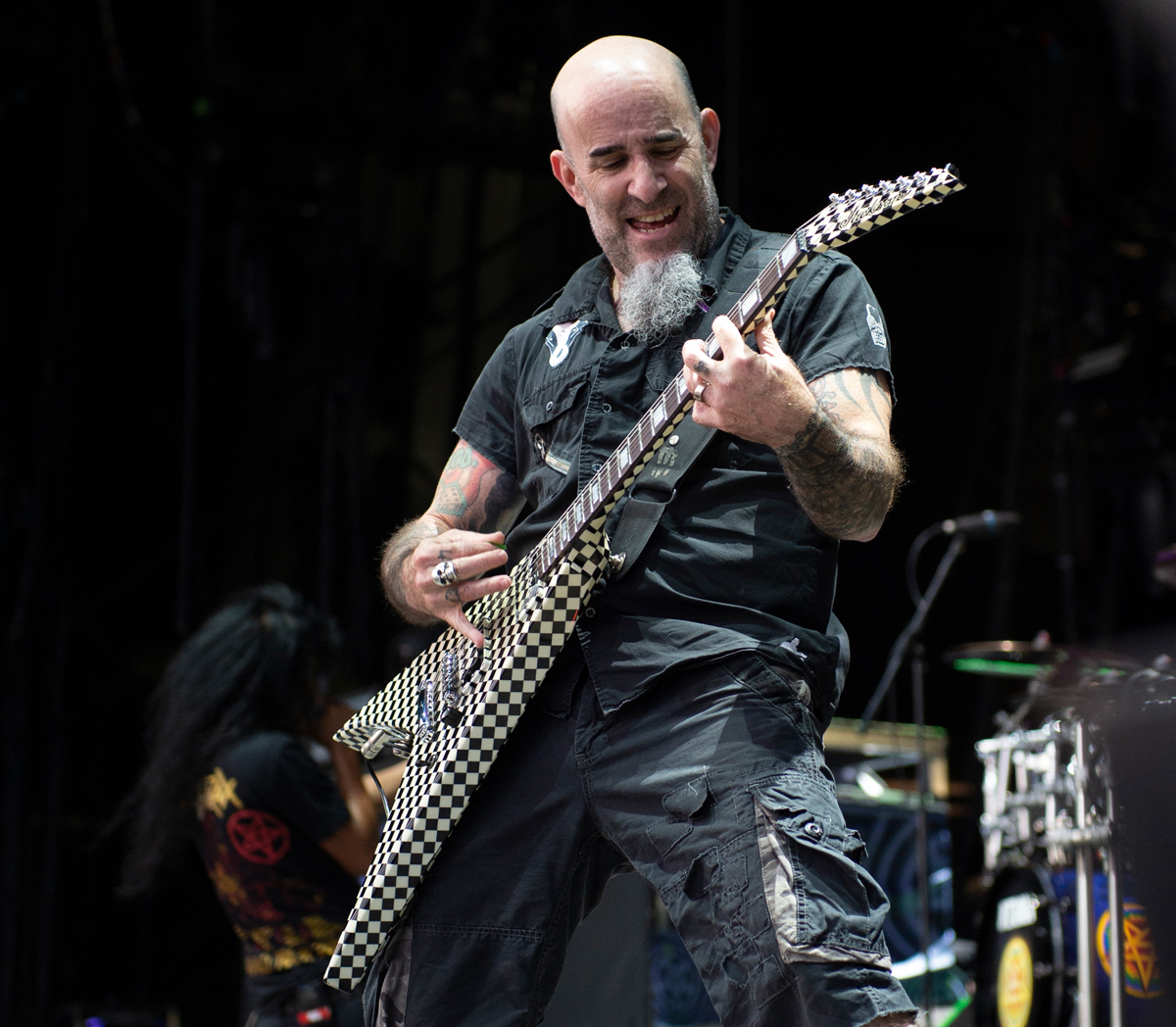Anthrax's Scott Ian on his thrashtastic history with Jackson guitars, shredding with his son and how an unlikely fretboard shaped the sound of Bring the Noise
One of thrash metal's most bankable rhythm players recalls how Randy Rhoads first drew him to the storied US brand and explains why he's digging the company's newly launched American Series Soloist

When it comes to brand ambassadors, few are as iconic for Jackson as Anthrax’s Scott Ian.
Since the dawn of the ‘80s, Ian’s unrelenting thrash precision has primarily been dealt out with a Jackson in hand. He delivered fistfuls of metal with his first custom Rhoads Concorde; chunked through the thrash-rap hybridity of Bring the Noise with a Soloist; hoisted a double-horned JJ model in the early ‘00s; and has worked through Anthrax’s modern-day renaissance with an arsenal of signature X-Series King V’s.
Simply put, Ian’s a lifer, through-and-through.
With all that history, Ian was pumped when Jackson gave him a sneak peak of their new SL3 Soloist – the update marking the first time the company has mass-produced the high-performance shred machine from their Corona, CA factory in their 40-year history. The alder body S-shape with a maple Speed Neck arrives in Riviera Blue, Gloss Black, Platinum Pearl, and Satin Slime Green finishes.
While the three-pickup system of the new American Series is set up differently to Ian’s ‘80s-era, Yankees-logo embossed custom Soloist – which had a single JB in the bridge position – handling the SL3 brought him back to his days cruising Manhattan’s guitar district in the ‘80s, mouth agape as he pulled the earliest Soloists – in his mind, the cooler, pointier Strat – off the wall on his lunch breaks.
“They were the best-feeling guitars I’d ever felt, so much faster than their forefathers – the Fenders and the Gibsons,” Ian recalls. “Not to sound like a TV commercial, but they were built for speed. That’s why everybody in metal started playing them in the ‘80s, because they were made for that style of playing. The necks are so god damn fast, I love it. They gave me a white one months ago [the Platinum Pearl SL3]. It’s one of my main guitars that I’m going to use on tour.”
To celebrate the launch of the American Series Soloist, Ian took stock of his 40-year journey with Jackson.
Get The Pick Newsletter
All the latest guitar news, interviews, lessons, reviews, deals and more, direct to your inbox!
You recently posted a photo on Instagram of a high school talent show of yours where you’re playing your first guitar, a ’72 Tele Deluxe. Since you’ve been so closely associated with Jackson over the years, how many guitars had you gone through before you made the switch?
I saw a Jackson Rhoads hanging on the wall after seeing Randy play with Ozzy, and I couldn’t believe it. Like, you can get his guitar!
“I would’ve got my first electric, that Tele, either in ’72 or ’73, so it was nine years, because I ordered my Rhoads in ’82. Thinking about it in that context, nine years doesn’t seem like a long time, but from the age of 10 to 19 – from the time I started playing guitar, to when I was sitting in Sam Ash, ordering a Rhoads Concorde – you might as well tell me that was a hundred years. There were many guitars in between, though.
“I really wanted a Strat as my first guitar – that was my favorite shape – but my family couldn’t afford that. We went to a little guitar shop not far from where we lived in Long Island, and they had that Tele. What I loved about it was that the Tele Deluxe had the big, beefy Strat headstock; it didn’t have that skinny Tele headstock, which I still don’t like. And it had humbuckers in it.
“It was a great guitar! It worked really well for me for a long time, until I started working and was able to start saving money [for another guitar]. I sold the Tele, and with the little bit of money I’d saved I got my first Strat, which was a natural wood-colored with three single-coils – I quickly had the bridge position routed out and had a humbucker put into it. I was off to the races at that point.
“And then it was Charvels. I started seeing Charvel Strat-shapes and Star bodies coming into the guitar shops in Manhattan before Jackson – I didn’t even know what a Jackson was until I saw Randy [Rhoads] playing one – and I was like, ‘Damn, what are these things?!’ This is what I imagined I wanted to do with my Stratocaster. Someone was already hot-rodding the guitars in advance.
“So, I had a Charvel San Dimas and a Star body probably in ’81-’82. Then Jackson took it to the next level. I saw a Rhoads hanging on the wall after seeing Randy play with Ozzy, and I couldn’t believe it. Like, you can get his guitar! It was pretty amazing.”
A post shared by Scott Ian (@scottianthrax)
A photo posted by on
Maybe part of this was the pure appeal of having seen Randy play one, but if you started out wanting to hot-rod a Strat, what drew you to the aesthetic of the Concorde?
“I was also a big Flying V fan, but I couldn’t afford a Gibson back then. But I saw the Blizzard of Ozz tour twice, and then I saw them on Diary of Madman as well. I loved what [Randy] did with the V [shape]. He made it his own. And, of course, his tone was insane.
“The fact that they came out with that Rhoads... nobody was doing that back then. I could be totally wrong, but I don’t remember seeing signature models. You could buy a Les Paul like the one Jimmy Page played, but there was something different about [the Concorde].
I was obsessed with Randy Rhoads. I would go into the Sam Ash every day on my lunch break, take his signature model off the wall, and play it for an hour
“Jackson was brand-new, and [the Concorde was] a very specific shape that only Randy was playing. You couldn’t buy a Frankenstein back then; nobody was selling anything modeled after Eddie’s guitars yet, but here’s a Concorde hanging on the wall. It was crazy to me, and I had to have one.
“I was obsessed with him. I would go into the Sam Ash every day on my lunch break, take the thing off the wall, and play it for an hour. I finally saved up enough money to custom-order one towards the end of ’82.”
What were you seeking, in terms of the specs?
“Just something super-basic with a Floyd Rose, which was also relatively new in 1982. I had a Fernandes Strat-shaped guitar that had a Floyd on it, which I think that might’ve been my first one; my Charvels had the stock tremolo and they worked ok.
“I had a very specific idea for the finish on [the Concorde]. I had ordered it with this yellow-and-black leopard [finish], but when it came in, I hated it. It didn’t look right to me, so I immediately sent it back in to be refinished with some graphics that I had drawn. That’s the one that everybody knows, the white Rhoads that I played all through the ‘80s.
“I had a very strong vision and idea of what I needed out of a guitar at that point, which was basically: bridge pickup, volume control, Floyd Rose. I didn’t need anything else. And I had already found the tone with the Marshall JCM800 and a TC Electronic Booster distortion pedal. It was the magic combination.”
How long was that Concorde your main guitar?
“I might’ve taken it off the road after [1987’s] Among the Living. I think by the time we were touring State of Euphoria, which started in ’88, I was [primarily using a] Soloist – I was also playing ESP for a couple years in that same time period. I’m pretty sure I had left the Rhoads at home by that point, because I was too scared of anything happening to it. It was the main guitar on the first five Anthrax records, and the S.O.D. album [1985’s Speak English or Die].
“I also have an ‘81 Gibson V that I drop-tuned to D for the March of the S.O.D. track, and maybe Keep It in the Family from [1990’s] Persistence of Time, but otherwise I was using the Rhoads.”
How did you transition towards making the Soloist your next workhorse?
Danny Spitz and I both wanted to play Jacksons… With whoever was doing the A&R for Jackson at the time, the actual word that came back about was: 'Well, we’re thrilled about Danny, but why would we endorse Scott? He’s the rhythm guitar player'
“Around the time [1985’s] Spreading the Disease was coming out, we had signed a major-label deal with Island Records. Our manager was trying to get endorsement deals, because we didn’t have money to buy proper professional gear for touring.
“[Former Anthrax lead guitarist] Danny Spitz and I both wanted to play Jacksons, of course. With whoever was doing the A&R for Jackson at the time, the actual word that came back about was: 'Well, we’re thrilled about Danny, but why would we endorse Scott? He’s the rhythm guitar player.' They wouldn’t do it. I gotta say, I was angry and sad. Like, what kind of bullshit is that!
“A buddy of mine worked at ESP in New York at the time, and said they’d be happy to make some guitars. They couldn’t do a Rhoads shape, obviously, but they had Strat/Soloist shapes with a similar pointy headstock to Jackson’s, so they built me a couple of guitars to take on tour. I put a Duncan JB in those, and they sounded good, but it wasn’t what I really wanted. I would look over at Danny with his cavalcade of Rhoads on the side of the stage – like eight of them – and I was just bummed. I was constantly reminded that I wasn’t playing Jackson.
“At some point in either late ’88 or early ‘89s, Jackson rectified their mistake [laughs]. There was a changing of the guard, and another friend of mine from a guitar shop on 48th Street started working for Jackson. He immediately said, ‘Hey, we would love to have you over here,’ and I couldn’t have said yes fast enough.
“The first thing they did was build me the Soloist, which is fretless after the 14th fret, has the big inlay [on the fretboard] that says “NOT” on it, and has the New York Yankees logo on the body – that became my next most iconic guitar. It became the workhorse for the next four or five years. I was basically back to where I started – I always wanted a Strat, and now I’m playing that shape with a cooler headstock. They’re just super-crunchy and so easy to play.”

Why did you decide to go fretless after the 14th on that Yankees guitar? Did you keep that up with any of your other Soloists?
“That was a one-of-a-kind, [and] I basically did it to be an asshole [laughs]. I was an outspoken rhythm guitar player. Like, 'I’m the fuckin’ rhythm guitar player, and I’m proud of it; I don’t need frets up there, because I don’t use ‘em.' I was just being a dick, basically. Of course I play at the top of the neck sometimes, but I was making a statement, almost to say: 'Hey, guess what, I’m playing Jacksons now… and I’m the rhythm guitar player.'”
“A lot of attention got paid to the fact that the guitar that was fretless after the 14th fret. That guitar is used on Bring The Noise, where I’m emulating the horn sample from the original Public Enemy version. I’m basically running my index fingernail up the fretless part of the B string, emulating that horn. On one of our biggest recordings of all time, you’re hearing how I created something with the fretless part of that guitar.”
What can you recall about building your signature T1000 Silverburst soloist with Jackson, several years later?
“That was the first time I got to go into the custom shop with Mike Shannon and actually be a part of tweaking the guitar. I had [been playing] Jackson before I was an [endorsed] Jackson artist, and then I became a Jackson artist in the ‘80s, all the way through the ‘90s when I was playing Surfcasters and JJs mainly. And then Jackson went away; they weren’t a company for years and years. When I got the call sometime around ’09 about coming back and designing a signature model, I was thrilled because I’d only ever wanted to be a Jackson guy.
“We took a body, and I got to put it on the machine and sand it. I think I even brought the New York Yankees Soloist out there. They basically just copied that guitar, but changed the contour a little bit.”
Have you got your hands on one of the new American Series Soloists yet?
“They sent me one a couple of months ago, just so I could live with it and check it out. It’s a pretty big deal that after 40 years there’s finally an American production series for Jackson. It’s not just that they’ve got some new custom guitar coming out; this is a full-time production series, American-made. I’m thrilled that Fender has the confidence in the brand, and has revitalized a brand that was literally gone in the ‘00s. They’ve got great people working there and building the guitars.”

The SL3 is set up differently than the old Yankees Soloist – it has the humbucker in the bridge, with a pair of single coils…
“There is a lot more going on, [but] I’m not necessarily going to use all that in the context of the Anthrax show. But there are a couple songs where I play harmonies, so it would probably make sense to use it and flip up to the neck position pickup when I go up for the harmony. Maybe I’ll end up using that on Antisocial, where it’s got the clean intro, and I’ll flip it back to the humbucker once the song kicks in.”
Can we get into some other custom pieces in your collection, like this one mirror-plated X-Series King V you’ve shown off on Instagram? You’ve spoken in the past about how one of your King Vs has lightning bolt inlays as a tribute to Malcolm and Angus Young; since you’re also a Kiss fan, is the mirrored pickguard on that V a nod to Paul Stanley’s Mirrorball Ibanez?
“No, it’d have to be broken if I was doing that. I just wanted to have a mirror! Funnily enough, though, they built me two of those V’s: one with a Floyd and one without. I happened to be out at the custom shop when they were being built, and the mirror cracked [on one of the guitars]. They asked, ‘Do you want to keep this, or do you want us to redo top?’ At first, I was like, “Well...it’s kind of a Paul Stanley thing,” but not nearly [as intense] as what his looks like — these were just little crack lines. It just didn’t look good. If I were to make a Paul Stanley tribute I’d do it correctly, because I love that guitar.”
A post shared by Scott Ian (@scottianthrax)
A photo posted by on
What’s the most work that’s gone into one of your Jacksons – whether that’s been via upgrading, or after any onstage disasters?
“I’ve never had any disasters. The closest we had to that was we had a fire in our rehearsal room in New York way back in 1990. Luckily for me, all of the guitars I had were across the room from where the fire had started. My iconic Rhoads was there, but no damage to it at all; my Gibson V was closer, and the outside of the case got a little burned.
“When we’d gotten the gear out of there, I opened up the case and the volume and tone pots were melted and misshapen; the paint on the horns got hot to the point where [the finish was] bubbling. I never repaired it; I just love the misshapen pots and the fucked-up paint. If I take a chunk out of a guitar live, I leave it. I don’t want it fixed.
“As far as work going into the building of a guitar, that’s probably my Rick Nielsen King V, the checkerboard one, because that’s painted. It’s not a wrap. It was a beast for them to do it properly, but, man, was it worth it. It looks incredible!”

Is that your son, Revel, I can hear playing guitar in the background?
“Yeah.”
What can you say about the two of you jamming covers on Instagram? He’s played the drums while you’re taking on Mastodon songs at home; you did the tandem guitar attack on Raining Blood for another post…
“He’s in the background playing Caught in a Mosh right now, which makes my heart swell. We’ve got those digital Fender Mustang amps in the house, and he’s got them so wired. He knows how to hook up his Fender app on the iPad, connects it to the amp with Bluetooth, and creates all his own tones using the pedals within the app. I’m such a caveman when it comes to a lot of that stuff. I just plug into it like, 'Oh, there’s a preset that says “metal”? I’ll use that one!' He’s created 50 of his own tones with these things. It’s amazing.
“It's the best feeling, seeing his passion. Obviously, I was on a similar path, so it’s very familiar to me – albeit [that was] at an older age. For me, it started around 14, and for him it started at around 8. He’s way ahead of the game. He can play my rhythm parts already, and he’s 11! It’s beyond me. You mentioned Mastodon – he learns Mastodon songs on guitar and drums. His passion for [music] really has no boundaries.”
A post shared by Scott Ian (@scottianthrax)
A photo posted by on
Did you start him on a Jackson?
Scott Ian: “No, the first one that he wanted as his own guitar was the Jim Root black Strat.”
Revel Ian: “It was sort of like you with the Concorde!”
Scott Ian: “Jim Root is still one of his favorite guitar players. He really wanted that a few years back for his birthday. That’s his go-to, even though he has other guitars, and obviously we have many guitars to choose from at the gear locker. It’s the one that he fell in love with first.”
It’s been six years since Anthrax released For All Kings. Where are you at with making another record?
It’s fun to be working on the new stuff backstage, and then going out to play it super-loud at soundcheck
“I have my own math when it comes to that. I think you can only count it as three years, because the pandemic essentially stole a few years from us. We did have a couple of writing sessions here and there, but nothing moved forward until we were able to all be in a room together again, and that was almost three years on from the last time we had been in a room together [pre-pandemic]. We certainly would have had a record out already if the world didn’t go to shit. There’s no rush, though. We’re working on it, and we’re really happy with where we’re at musically.
“Getting back out on tour is going to be the best thing for us, because we haven’t done that since the end of 2019. We’re going to be able to get out there again, have our backstage setup, and get to jam in the dressing room. That’s where a lot of this comes from: us being bored during the day, and [then using] that time creatively.
“It’s fun to be working on the new stuff backstage, and then going out to play it super-loud at soundcheck. We’re pretty well along. We’ve got 8-10 great arrangements, and lyrics for about half of it. I think over these next few months we should be at a point where we’ll be much closer to actually commit to [making a record].”
- For more information on the Jackson American Series Soloist SL3, visit Jackson Guitars.
Gregory Adams is a Vancouver-based arts reporter. From metal legends to emerging pop icons to the best of the basement circuit, he’s interviewed musicians across countless genres for nearly two decades, most recently with Guitar World, Bass Player, Revolver, and more – as well as through his independent newsletter, Gut Feeling. This all still blows his mind. He’s a guitar player, generally bouncing hardcore riffs off his ’52 Tele reissue and a dinged-up SG.
“I was in a frenzy about it being trapped and burnt up. I knew I'd never be able to replace it”: After being pulled from the wreckage of a car crash, John Sykes ran back to his burning vehicle to save his beloved '76 Les Paul
“His songs are timeless, you can’t tell if they were written in the 1400s or now”: Michael Hurley, guitarist and singer/songwriter known as the ‘Godfather of freak folk,’ dies at 83










